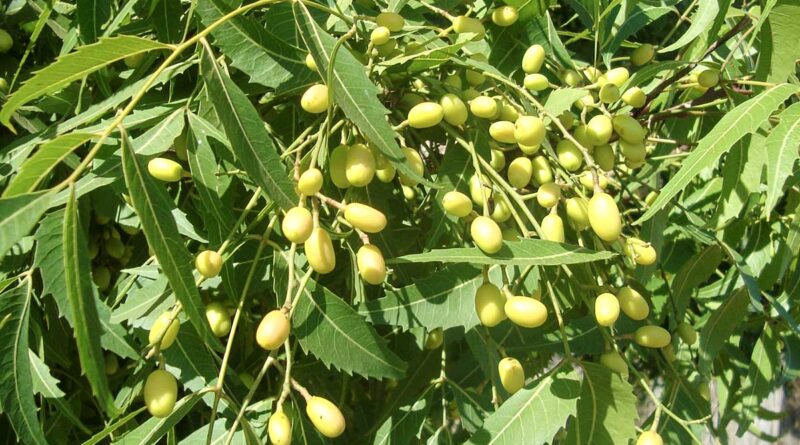Why Neem Deserves a Place in Every Home
By Hauwa Muhammad Bamanga
Neem (Azadirachta indica), popularly known across Nigeria as dogon yaro (Hausa), Ogun jàwò (Yoruba, variants), and Ògwu ọjị (Igbo, variants), is among the most widely used medicinal trees in West Africa. Traditional preparations from its leaves, bark, seeds, and twigs are used for malaria, fever, skin infections, oral hygiene, and as household insecticides. A growing body of laboratory and animal studies supports many of these uses, pointing to bioactive compounds such as azadirachtin, nimbin, nimbidin, and gedunin with antiplasmodial, antimicrobial, anti-inflammatory, and insecticidal effects. While neem is generally regarded as safe in customary doses, concentrated oils and high-dose extracts can be toxic—especially for infants and pregnant women—underscoring the need for dosing guidance and quality control. This article synthesizes ethnobotanical practice in Nigeria with current evidence and practical guidance for safe, community-level use and future research priorities.
Traditional uses and household forms
Leaf decoction/infusion: for fever, malaria symptoms, and general “blood cleansing.” Often taken warm and bitter, sometimes blended with other herbs. Reports from Nigeria specifically note concomitant use with conventional antimalarials—an important safety consideration
Chewing sticks (twigs): for dental plaque control and gum health; their mechanical action and phytochemicals contribute to antimicrobial effects.
Topical pastes and oils: crushed leaves or seed oil for skin infections, ringworm, and minor wounds; diluted oil used against hair lice and as a household insect repellent.
Smoke/fumigation and stored-grain protection: dried leaves added to grain stores or burned to repel mosquitoes and pests.
Dermatologists Jeanine Downie, MD, and Anna Guanche, along with cosmetic chemists Victoria Fu and Gloria Lu, discuss neem oil for acne. They emphasize its antibacterial, antifungal, and anti-inflammatory properties, recommend patch testing, and caution about possible skin irritation.
Times of India in a recent article outlines eight key benefits of neem for maintaining healthy, glowing skin. It highlights neem’s use in face packs, oils, and cleansers, while providing safety tips.
“It also consists of anti-bacterial, anti-fungal, anti-inflammatory and antiseptic properties. Vitamin E present penetrates into the skin, locks in the moisture, boosts the collagen and elastin production, helpful for ageing skin, reducing acne scars.” Said Dr. Nivedita Dadu, A Dermatologist
Aisha Aminu is a mother living with her children at Rimin Gata said “Whenever my children have fever or stomach upset, I boil neem leaves and give them to drink. It is bitter, but after two days they always feel better. We call it ‘dogonyaro’ here, and it is our first medicine before we even think of going to the hospital.”
Malam Aminu who is a farmer said “Neem is very important for us farmers. I use the leaves and seeds to spray on my crops as natural pesticide. It protects my beans and millet from insects without spending money on chemicals.”
Phytochemistry at a glance
Neem’s pharmacological breadth stems from a complex mixture of limonoids and other constituents: azadirachtin (notable insect growth regulator), nimbin, nimbidin, gedunin, salanin, and quercetin-type flavonoids. These compounds are variously anti-inflammatory, antimicrobial, antiplasmodial, or insecticidal in preclinical models.
Antimalarial/antipyretic potential: Multiple in-vitro and animal studies show antiplasmodial activity of neem extracts and limonoids like gedunin. In Nigeria, leaf decoction is widely taken for malaria; one local study documented frequent co-administration with chloroquine among rural users—useful as context for patient counseling. Clinical evidence remains limited and does not support neem as a standalone curative therapy for confirmed malaria; rather, it may have an adjunct or symptomatic role.
Antimicrobial activity: Laboratory work demonstrates antibacterial effects of leaf and bark extracts against common pathogens (e.g., Staphylococcus aureus, E. coli), aligning with topical folk uses for skin infections. Recent Nigerian data continue to report antibacterial activity, though extract standardization varies across studies.
Anti-inflammatory and immunomodulatory effects: Extracts rich in nimbidin suppress pro-inflammatory pathways and leukocyte activity in animal models, offering a mechanistic basis for pain/fever relief reported by users.
Metabolic effects: In diabetic-model animals, aqueous leaf extracts have shown improvements in lipid profile and some organ-function markers, suggesting future potential for supportive care—pending rigorous human trials.
Safety, contraindications and quality
Infants & pregnancy: Neem seed oil and high-dose extracts have been associated with toxicity; avoid in infants and during pregnancy unless supervised by a qualified clinician. Traditional weak infusions are generally considered safer than concentrated oils.
Oral hygiene: Use clean, fresh neem twigs as chewing sticks; avoid splintered or moldy sticks. Replace frequently.
Conclusion
Neem (dogon yaro) is deeply embedded in Nigerian daily life and traditional medicine. Evidence supports several of its long-standing uses—especially antimicrobial, anti-inflammatory, and insect-management roles—while emphasizing sensible safety guardrails and the primacy of modern treatments for conditions like malaria. With measured integration into public-health messaging and improved quality control, neem can continue to serve as a culturally consonant, affordable complement to Nigeria’s health system.





